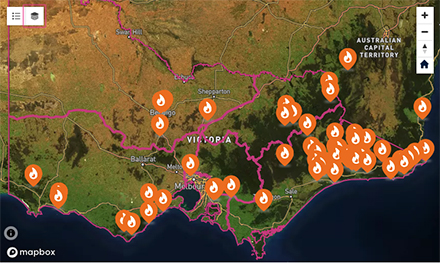The 2019-20 bushfires throughout Gippsland and Victoria’s north-east burnt 650,000 hectares of native forest set aside for the timber industry and released more than 50 million tonnes of forest carbon stocks into the atmosphere, according to a government report. Source: Philip Hopkins for Timberbiz
The fires affected nearly 760,000 ha of Victoria’s comprehensive, adequate and representative (CAR) reserve system, which totals 4.3 million ha. Of this, 2.9 million ha are in the RFAs.
The recent 95,000 ha Immediate Protection Area for the Greater Glider and Leadbeater’s Possum was half burnt, with more than 31,000 ha burnt by high severity fire.
The figures are contained in a Major Event Review conducted by the Victorian and Australian governments that aims to assess the impacts of the huge bushfires on the operation of Victoria’s five Regional Forest Agreements.
The review, which does not open up the RFAs for renegotiation, is taking public comment. A final report is expected in November.
The RFAs, originally signed between 1997 and 2000, aim at a sustainable economic, ecological, recreational and cultural use of native forests. They have been rolled over in a ‘modernisation’ process until 2030, when the Andrews Government will cease native forest harvesting.
The 2019-20 bushfires burnt 1.5 million ha of land within the RFA areas of East Gippsland, Gippsland and North East, of which 1.3 million ha was forested. Small fires also affected the West and Central Highlands.
Within the RFA regions, the fires burnt 870,000ha of State forest and 67,000ha of forest on private land. Affected were 70% of the forest in East Gippsland, where 47% of forest was hit by high severity fire. High severity fire burnt 51% of the forest in the North East and 50% in Gippsland.
Of the fire-hit 650,000 ha set aside for timber harvesting, about 40,000 ha was Ash forest, including 7800ha of immature Ash forest affected by high severity fire. Most of the area burnt (610,000 ha) was mixed-species eucalypt forest.
“These species typically survive most fires and regenerate by resprouting after fire,” the report said, adding: “Ash species are typically killed by high severity fire and regenerate through seeds from the canopy. If killed before they reach seed-bearing age (about 20 years), Ash forests may not regenerate.”
VicForests confirmed that 340,000 cubic metres of fire salvage harvesting was conducted after the fires. During the fires, “many forest industry businesses experienced a reduced capacity to operate because of power loss and road closures”, the review said.
The report estimated a net decrease in forest carbon stocks of 55 million tonnes in 2019-20, but “some carbon will be reabsorbed through regrowth of the forest over the coming years”.
“This includes emission of 57 million tonnes due to fire and sequestration of two million tonnes due to post-fire regrowth in 2019-20,” the review said.
These figures only related to carbon dioxide emissions, not methane emissions, with work under way to assess the total emissions of greenhouse gases from the fires.
The review analysed the impact of the fires on Victoria’s biodiversity, including on species listed under the Environmental Protection Biodiversity and Conservation Act and Victoria’s Flora and Fauna Guarantee Act. “This process has highlighted species of immediate concern,” the review said.
A total of 244 species with more than 50 per cent of their modelled habitat were identified in fire areas, including 215 rare or threatened species and four listed under the EPBC Act.
“Species of most immediate concern include the Long-footed Potoroo, Ground Parrott, glossy Black-Cockatoo, Large Brown Tree Frog, Diamond Python and Freshwater Galaxiids species,” the report said.
Other key aspects of the review report included:
- About 6400 ha of the total 416,000ha of plantations was affected. There will be likely long-term impacts on timber supply as plantations need to be replanted and grown.
- Floral resources for honey and pollination from forests will decrease in the short-to-medium term, reducing honey volumes, but capacity is expected to recover as forests regenerate.
- Tourism revenue from forests and summer beach holidays fell by $330-350 million in bushfire-affected regions.
- There are no Ramsar sites in the fire extent, but indirect impacts on the Gippsland Lakes Ramsar site resulting from soot, ash, sediment and black water may become evident over time.
- The bushfires affected signs, picnic and camping facilities, walking tracks and mountain bike trails, resulting in $30 million damage to buildings and infrastructure.
- No on-ground assessments have yet been taken on the more than 1000 known registered Aboriginal heritage places.
- Of the more than 130 known non-Aboriginal heritage sites, 21 sites on the Victorian Heritage Register were directly affected.
For more information, copy the following link:
https://engage.vic.gov.au/major-event-review-victorias-regional-forest-agreements






